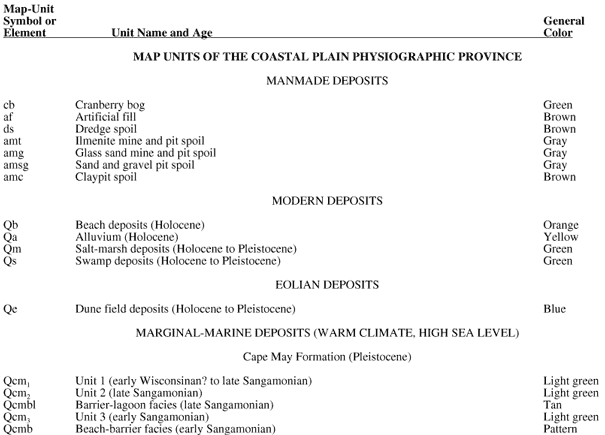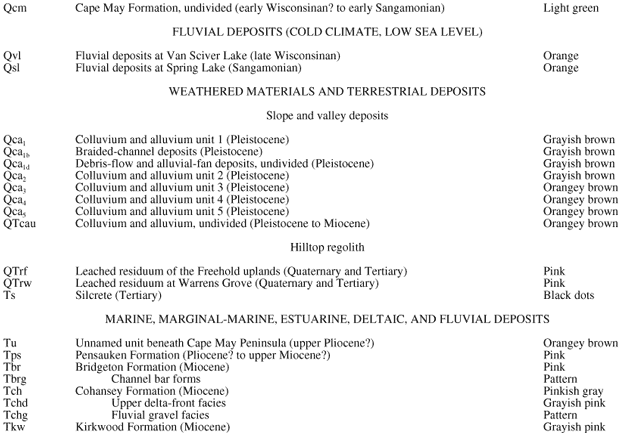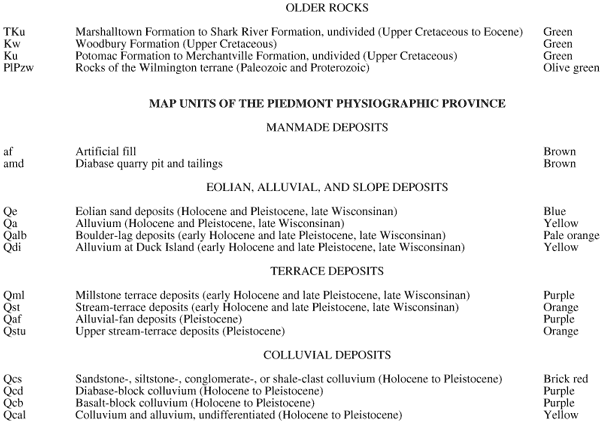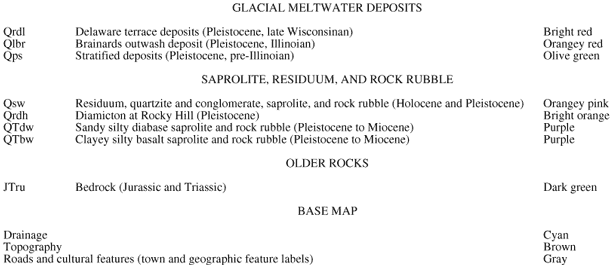
Digital Mapping Techniques '01 -- Workshop Proceedings
U.S. Geological Survey Open-File Report 01-223
Cartographic Choices for the Surficial Geologic Map of
Central and Southern New Jersey
By Will R. Stettner and Elizabeth D. Koozmin
U.S. Geological Survey
National Center, MS 903
12201 Sunrise Valley Drive
Reston, VA 20192
Telephone: (703) 648-4343
Fax: (703) 648-6138
e-mail: ekoozmin@usgs.gov
INTRODUCTION
The Surficial Geologic Map of Central and Southern New Jersey (Newell and others, 2000) consists of portions of eight 1:100,000-scale quadrangles. This map was a product of a cooperative agreement between the U.S. Geological Survey (USGS) and the New Jersey Geological Survey; the USGS did final compilation, editing, and production. The authors began field work in 1984; their first compilation was completed (using traditional ink-on-greenline methods) and reviewed by 1996. The resulting product is a model not only of a geomorphic system that has responded to extreme climate changes, but also of modern surficial processes, including the influence of humans on the landscape.
After peer review, the editing and production of the maps began in 1996. A decision was made to forego digitizing the map in ArcInfo and bridge the traditional-to-digital cartography gap by employing digital graphic production methods (such as Adobe Illustrator). Much of that decision was due to the state of the base-map materials and the fact that current technology had far supplanted their usefulness. Map editing was done using the hand-colored paper copies. Corrections were then made to the greenlines.
There are 65 map units, two of which are shown only in the cross sections. Linework consists solely of contacts, scarps, and arrows showing sediment flow directions or channels. Compared with a bedrock geologic map (which may have contacts, folds, faults, structural data, and many other features), one might think that the surficial counterpart would be much simpler to produce. A closer look at the maps, and some details about its production, reveal a deeper complexity.
GEOLOGIC LINEWORK AND POLYGONS
The production tool of choice in the USGS Eastern Publications Group is Adobe Illustrator (AI). Creating AI files from the greenlines presented a challenge to the cartographers. First, a traditional cartographer scribed the geologic contacts in order to get clean, smooth linework with which to work. Film positives were made from the scribecoats. The film positives were given to a contractor, Geologic Data Systems (GDS) of Denver, Colo., to be scanned. Raster images of the linework were then autovectorized and edited to produce geologic unit polygons.
The southern sheet was digitized and the polygons were tagged with the geologic unit identifications by GDS using AutoCAD. The data were exported as DXF files. Using the MAPublisher filter, the files were opened in AI, whereby each unit was automatically placed in its own layer; however, the DXF format had a limit of the number of nodes that could be used to create a polygon, and exceeding that number prevented the AI file from opening. GDS modified the DXF files by decreasing the number of nodes, but this step took several iterations to complete.
The central sheet also was digitized using AutoCAD and tagged by GDS, but this time the data were exported as ArcInfo SHAPE files. Again, using MAPublisher, the files were opened in AI, this time more easily than the DXF files, but all the units were in one layer. The units then were manually separated into their own layers. The total number of polygons for both sheets is about 7,000.
BASE MAP
For the authors' compilation, before digital mapping technology had evolved, a photomosaic of the eight 1:100,000-scale quadrangles was produced. This mosaic was simply one combination of drainage, topography, and cultural features (roads, town and geographic feature labels, and so on). This method of producing compilation materials limited the options for a digital base map later in the process.
Once production was underway, a separate mosaic of the map's drainage linework (from the eight quadrangles) was produced. This mosaic was then scanned and digitized by GDS using AutoCAD. This step was necessary in order to ensure an accurate match to the geologic contacts because, for many of the units, either open-water shorelines (rivers, ponds, oceans, and marshes) or single-line drainages (creeks, some rivers) also acted as unit boundaries. After the geologic units were imported as described above, black geologic contact lines had to be "hidden" by the blue drainage lines. This task was accomplished in AI. Separate mosaics of culture and topographic contours also were produced and scanned.
COLOR
Geologic Unit Colors
Another cartographic challenge was choosing colors. The traditional colors for Quaternary and Tertiary units on U.S. Geological Survey maps are limited to yellows and oranges. With 65 units and a wide variety of environments to be represented, the colors shown here are a drastic departure from tradition (see table 1).
The Quaternary sediments found throughout the map needed to contrast with the Tertiary and Cretaceous units, so they retained the traditional oranges and yellows. Dark browns, grays, and a dark green (for cranberry bogs) were used to show manmade units. The dune field deposits (unit Qe) needed to stand out on their own, so they are the only blue polygons on the map.
In the Piedmont, the authors wanted the very small colluvial, alluvial, and terrace deposits to be visible against the widespread residuum (unit Qsw). In addition, the diabase- and basalt-block colluvium, which were weathering products of the Triassic basin rocks, needed to be emphasized so that the underlying bedrock trend could be expressed. The entire Piedmont had to stand out clearly from the Coastal Plain, and it had to be matched to the unfinished northern sheet by Stone and others (in press); as it turned out, the color choices made on the central sheet eventually influenced many of the colors on the adjoining northern sheet.
In the Coastal Plain, there were several issues. The Pleistocene beach-barrier to lagoon units of the Cape May Formation needed to contrast with the modern beach deposits, so they were assigned a suite of bright green-yellow tones. A distinction needed to be made between freshwater-swamp and salt-marsh deposits, but both had to be green. The Pleistocene colluvial units needed to contrast well with the Tertiary and Cretaceous units from which they were derived. Lastly, the sinuous traces of ancient river-channel bar forms developed on the Bridgeton Formation needed a subtle representation; use of a pattern resolved that problem.
Base-Map Colors
The drainage is shown in 100 percent cyan ink as is typical of most USGS geologic maps. Because of the density of information, the underlying culture and topographic layers needed to be readable only in the background of the map. These two layers also had to be distinguished from each other. The contours are shown in 100 percent contour brown (an ink used by the USGS on topographic sheets). Usually, the base map on USGS geologic maps is shown using a 50 percent biangle screened black, which breaks up the image somewhat. For this set of maps, a 100 percent gray ink was used instead because the culture was a raster image and screening it would have made it illegible.
REVISIONS
Of course, no map is perfect the first time it is proofed. Authors and editor reviewed many color plots before and after the base-map information was added. Three sets of problems needed resolution.
Because the digitizer at GDS was tagging polygons using the authors' hand-colored draft copy as a guide, some polygons were, in the end, unidentifiable and were tagged as such. Working with the authors, the cartographer was able to resolve these errors.
As mentioned above, joining the geologic contacts with the drainage required patient examination of many of the units for accurate placement. For instance, the alluvial units needed to be centered on the drainage. They also had to "V" upstream according to the topography.
In addition, when the senior author finally saw his map in a cleaner form, he observed that certain areas needed to be "fine tuned" for a variety of reasons. These types of adjustments were made in several areas on both sheets. In addition, the central sheet needed to join accurately with the northern sheet of Stone and others (in press).
However, the AI files were now far removed from the original DXF and SHAPE files. It is possible that, in the future, the AI files will be exported through MAPublisher to ArcInfo where they would become a useful part of a larger database (for instance, the National Geologic Map Database).
SUMMARY
If these maps had been produced using the traditional scribecoats for linework and peelcoats for color separation, modification to both linework and color after the first proof would have been very difficult, time consuming, and expensive. Adobe Illustrator gave the production team and the authors a chance to easily adjust contacts and to modify the colors until the right combination was reached. The resulting product visually presents the cumulative effects of geomorphic processes that have affected the landscape since the early Miocene (about 24 million years ago).
REFERENCES
Newell, W.L., Powars, D.S., Owens, J.P., Stanford, S.D., and Stone, B.D., 2000, Surficial geologic map of central and southern New Jersey: U.S. Geological Survey Miscellaneous Investigations Series Map I-2540-D, scale 1:100,000 (3 sheets and pamphlet).
Stone, B.D., Stanford, S.D., and Witte, R.W., in press, Surficial geologic map of northern New Jersey: U.S. Geological Survey Miscellaneous Investigations Series Map I-2540-C, scale 1:100,000.
RETURN TO Contents
National Cooperative Geologic
Mapping Program | Geologic Division |
Open-File Reports
U.S. Department of the Interior, U.S. Geological Survey
URL: https://pubsdata.usgs.gov/pubs/of/2001/of01-223/stettner.html
Maintained by David R. Soller
Last modified: 18:25:01 Wed 07 Dec 2016
Privacy statement | General disclaimer | Accessibility



